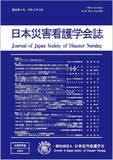Japanese
English
- 有料閲覧
- Abstract 文献概要
- 参考文献 Reference
要 約
目的 東日本大震災後、A県に広域避難した高齢被災者と継続的に関わる看護職者の生活支援に関する困難について明らかにする。
方法 A県に広域避難した高齢被災者と継続的に関わる看護職者を対象に半構成的面接を実施した。分析は質的記述的方法を用いた。
結果 研究参加者は4名であった。継続的に関わる生活支援に関する困難として【初期の関係性のため具体的な支援がみえない難しさ】【精神的ケアの難しさ】【家族生活の見通しが立たないが故の難しさ】【保健医療福祉サービスの継続支援の難しさ】【関連機関と協働することの難しさ】の5つのカテゴリーが抽出された。
結論 広域避難後、経年的に変化する日常生活の様々な課題に対して人間の健康に焦点を当て、関心を寄せる継続的な関わりこそが安心感を生み、保健医療福祉サービスの充実化を促進する。関連機関との情報共有の在り方を見直し、継続支援が途絶えないよう包括的な協働体制を築く必要性が示唆された。
Purpose
The purpose of this study is to clarify the difficulties concerning life support experienced by nursing staff continuously involved with elderly victims who were evacuated to a wide area of prefecture after the Great East Japan Earthquake.
Method
A semi-structured interview was conducted with nursing staff who were continuously involved with elderly victims who were evacuated over a wide area of prefecture. The analysis used a qualitative descriptive method.
Results
There were four study participants. The following five categories of continuous involvement were extracted: difficulty because it is a one-way activity; difficulty to provide mental care; difficulty to provide continuous support of health care and welfare services; difficulty of working with related organizations; and difficulty due to a lack of life prospects.
Conclusion
After evacuation over a wide area, we focused on human health to address various issues in daily life that change over time. It was suggested that it is necessary to review the way information is shared with related organizations and to build a comprehensive collaboration system so that continuous support is not interrupted.
Copyright © 2020, Japan Society of Disaster Nursing All rights reserved.


